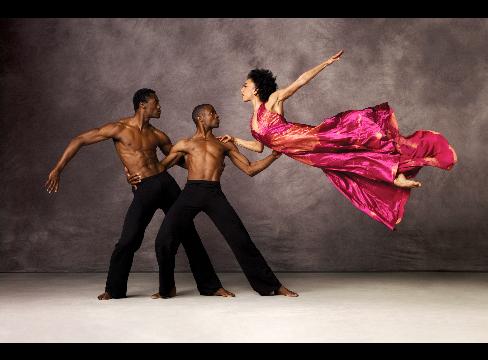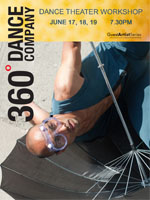Seeing Things: December 2008 Archives
This article originally appeared in the Culture section of Bloomberg News on December 5, 2008.

Alvin Ailey American Dance Theater's Jamar Roberts, left; Amos J. Machanic, Jr., center; and Olivia Bowman rehearse in this photo taken on May 9, 2007. Photographer: Andrew Eccles/Alvin Ailey American Dance Theater via Bloomberg News
Dec. 5 (Bloomberg) -- The Alvin Ailey American Dance Theater scorns doing things by half measures. Wednesday night's gala opening of its five-week season at the City Center, celebrating its 50th anniversary, pulled out all the stops. What other dance company commands celebrities like Oprah Winfrey and divas like Jessye Norman to play a supporting role in what is often called "the orphan art"?
Judith Jamison, the company's director, is a dazzling personality in her own right. Her speeches from the stage veered effortlessly from blithe humor to impassioned gravity. Winfrey's tribute was forceful and compelling. And the first-night audience, fabulously dressed for festivity, matched the onstage performance with an ogle-worthy fashion show at intermission.
By the way, there was some dancing. After a lively, concise film on the company's history, Ailey School students represented the rising generation in "Echoes of Alvin," choreographed for the occasion by former company dancer Christopher Huggins. Then the lovely Donna Wood, an unforgettable Ailey alumna, emceed five Ailey excerpts performed by the main company.
The evening closed with the choreographer's signature work, the 1960 "Revelations," which, as always, stirred the audience to a fever pitch. All the superb solo singers of the spirituals stood onstage with the dancers instead of being seated in the pit.
Diva Distraction
The effect distracted somewhat from the dancing (especially in the incomparable rendition of the "Fix Me, Jesus" duet by Linda Celeste Sims and Glenn Allen Sims), but in the case of Jessye Norman, one can't really complain.
After the customary encore of the closing few minutes of "Revelations," the dancers reverently laid the sheaves of white roses they received during the curtain calls on the floor beneath a giant photo portrait of Ailey and left the stage. As the audience departed, the curtain remained raised, the dancing space gently illuminated like a shrine.
The season will feature lots of the company's most striking works, a full week of programs devoted to choreography set to Duke Ellington music, performed live by the Jazz at Lincoln Center Orchestra with Wynton Marsalis, and two new pieces.
Ailey dancer Hope Boykin, who moves with a primal passion, has also begun a choreographic career. For her "Go in Grace," she's collaborated with the all-female vocal group Sweet Honey in the Rock, whose members will be mingled with the dancers.
The Italian choreographer Mauro Bigonzetti, who has sparked considerable interest in the U.S., will contribute "Festa Barocca," set to a Handel score and blending classical and modern-dance techniques, an Ailey specialty.
Ailey's Half-Century
The Ailey company's importance lies as much offstage as it does in the pyrotechnical and emotional feats his dancers routinely achieve.
Its founding a half-century ago was the familiar shoestring venture, but one with a unique goal: creating a company mainly of black dancers, who were, shamefully, often excluded from the field.
In recent years, superb management has achieved goals ranging from steady employment for the dancers to the building of a $56 million mid-Manhattan complex that houses the main company, a junior troupe (Ailey II) and the Ailey school.
Over the years, members of the company have received just about every major dance award. A charismatic ambassador for its art, the Ailey has crisscrossed the globe, performing all over the U.S. and Asia and in European temples of classical culture like the Paris Opera and St. Petersburg's Maryinsky Theater.
Jamison plans to retire in 2011. It's hard to imagine who might replace her until you realize she succeeded Ailey and, instead of things falling apart, had the Empire State Building glowing gold last night in the company's honor.
Through Jan. 4 at 131 W. 55th St. Information: +1-212-581- 1212; http://www.alvinailey.org.
© 2008 Bloomberg L.P. All rights reserved. Reprinted with permission.
This article originally appeared in the Culture section of Bloomberg News on December 1, 2008.
Dec. 1 (Bloomberg) -- It's too easy to yield to the magic of George Balanchine's "The Nutcracker," performed by the New York City Ballet. It's harder to define that enchantment.
Is it the Christmas tree that grows to a height of 40 feet before our eyes? Maybe it's the skill and verve of the School of American Ballet kids who hold their own against the professionals. Perhaps it's the female corps de ballet, each member a beauty in her own right, dancing in unison as snowflakes or flowers. Could it be the radiance and virtuosity of the principals?
The production, which opened Friday at the David H. Koch (formerly New York State) Theater for its annual five-week run, offers such pleasures. It amazes with old-fashioned theatrical marvels, enhanced by modern-day technology and the phenomenal technique of today's classical ballet dancers, bred to their trade from a young age. Yet, the ballet's real draw is its spirit.
Partnered with Tchaikovsky's celestial score, Balanchine's "Nutcracker" illuminates the idea that, whatever our real-life circumstances, extravagant dreams will abide in our lives.
The story, derived from E.T.A. Hoffmann's tale, is set in motion by the inventor Herr Drosselmeier. The eccentric old man leads his goddaughter (the pre-pubescent Marie) and his young nephew (who morphs from nutcracker to budding prince) out of the predictable comforts of upper-middle-class life into the Land of Sweets. This imaginary kingdom is one of unadulterated delight, though to approach it the children must overcome fear and life- threatening danger -- in the form of giant, menacing mice.
Drosselmeier Poetry
Robert La Fosse emphasized the poetry of Drosselmeier, while not forgetting the darker, subconscious motives that underlie his magic. As usual, the children under his spell were scrupulously rehearsed with no loss of spontaneous vitality.

Sara Mearns plays the part of The Sugarplum Fairy in the New York City Ballet production of "The Nutcracker" in New York in this undated handout photo. Photographer: Paul Kolnik/NYCB via Bloomberg News
The women taking the soloist roles were predictably good, but Sara Mearns, as the Sugarplum Fairy, regent of this delectable realm, went far beyond that, offering a passage of dancing in the duet at the ballet's climax that was sublime. From her long, languorous stretches though the air to her feline leap from a distance onto her cavalier's shoulder without a trace of preparation, her usual plush dancing was suffused with something indefinable yet ever-present -- the secrets of the soul, perhaps.
In the weeks to come, the casting will vary in the many principal and soloist roles, with the company wisely treating "The Nutcracker" both as a showcase for the veterans and a proving ground for potential stars.
Tomasson's 'Nutcracker'
A serviceable alternative "Nutcracker" for audiences far from New York or who are watching their budget these days is San Francisco Ballet's newest version, created in 2004 by the company's artistic director, Helgi Tomasson.
It will be telecast on Dec. 17 in PBS's "Great Performances" series and is available on DVD from Opus Arte.
To make his production unique, Tomasson uses a slideshow of vintage photos to set it in early 20th-century San Francisco with side trips to the later Victorian era. The second act, traditionally composed of individual dances evoking lands exotic to Americans, is tied to an ambitious 1915 exposition in the city that emphasized getting to know far-flung cultures.
The main trouble with the production lies in the concept of the young heroine, Clara (as she's called here). The lovely Elizabeth Powell, a ballet student who dances with impeccable grace, is simply too old for this role, too far along in the decorum classical dance training imposes on a docile pupil, with no recourse but to utilize every pretty ballet mannerism in the book. While, on one hand, she lacks the exuberance of a child, on the other, whirling in the arms of the adult Nutcracker Prince as if she were his love interest, her character seems to have forgotten warnings her mother surely gave her about older men.
Athletic
True, it's hard to resist Davit Karapetyan, a handsome fellow who has the uncanny ability to be simultaneously liquid and athletic in his movement.
The ominous mystery that lends the ballet the perilous dimension that makes it irresistible is absent. The life-size mechanical dolls Drosselmeier brings to the Christmas Eve party are suitable "Coppelia"-esque creations, but Damian Smith, playing their inventor, exudes none of the dark magic that usually inhabits those who fashion such wonders.
Apart from Drosselmeier, the character roles are beautifully done. Clara's parents are utterly believable -- mature, romantic, and good hosts. Even better are a grandmother with terrific elan and a slightly dotty grandfather, leading a social dance for three generations. The Mouse King, with his rapacious teeth and claws, is both comic and frightening.
Resplendent Costumes
The faux-exotic divertissements that constitute the second act, viewed by Drosselmeier and Marie -- so Karapetyan, inarguably the star of this show, can disappear to find a more age- appropriate ballerina for the duet -- are luscious, thanks to Martin Pakledinaz's resplendent costumes.
The smooth, adroit dancing from adults and kids alike is a tribute to the training Tomasson has instilled in the company and its school. Yes, this production lacks logical coherence and psychological depth, but there's enough eye-candy here to seduce all but the most exacting viewer who insists that a ballet should pierce the heart.
New York City Ballet will perform "The Nutcracker" at the David H. Koch Theater, Lincoln Center, NYC, through Jan. 3. Information: +1-212-721-6500 or http://www.nycballet.org. San Francisco Ballet's "The Nutcracker" will air on PBS's Great Performances Dec. 17 and is available as an Opus Arte DVD. Information: http://www.sfballet.org/nutcracker.
© 2008 Bloomberg L.P. All rights reserved. Reprinted with permission.
Sitelines
AJ Ads
 360° Dance Company at DTW offers two socially relevant revivals, Jane Dudley’s solo “Time Is Money” (1932) and Mary Anthony’s “Devil in Massachusetts” (1952) as well as the World Premier of Artistic Director, Martin Lofsnes' "6-1".
360° Dance Company at DTW offers two socially relevant revivals, Jane Dudley’s solo “Time Is Money” (1932) and Mary Anthony’s “Devil in Massachusetts” (1952) as well as the World Premier of Artistic Director, Martin Lofsnes' "6-1".
AJ Blogs
AJBlogCentral | rssculture
Terry Teachout on the arts in New York City
Andrew Taylor on the business of arts & culture
rock culture approximately
Laura Collins-Hughes on arts, culture and coverage
Richard Kessler on arts education
Douglas McLennan's blog
Dalouge Smith advocates for the Arts
Art from the American Outback
Chloe Veltman on how culture will save the world
For immediate release: the arts are marketable
No genre is the new genre
David Jays on theatre and dance
Paul Levy measures the Angles
Judith H. Dobrzynski on Culture
John Rockwell on the arts
innovations and impediments in not-for-profit arts
Jan Herman - arts, media & culture with 'tude
dance
Apollinaire Scherr talks about dance
Tobi Tobias on dance et al...
jazz
Howard Mandel's freelance Urban Improvisation
Focus on New Orleans. Jazz and Other Sounds
Doug Ramsey on Jazz and other matters...
media
Jeff Weinstein's Cultural Mixology
Martha Bayles on Film...
classical music
Fresh ideas on building arts communities
Greg Sandow performs a book-in-progress
Harvey Sachs on music, and various digressions
Bruce Brubaker on all things Piano
Kyle Gann on music after the fact
Greg Sandow on the future of Classical Music
Norman Lebrecht on Shifting Sound Worlds
Joe Horowitz on music
publishing
Jerome Weeks on Books
Scott McLemee on books, ideas & trash-culture ephemera
theatre
Wendy Rosenfield: covering drama, onstage and off
visual
Public Art, Public Space
Regina Hackett takes her Art To Go
John Perreault's art diary
Lee Rosenbaum's Cultural Commentary
